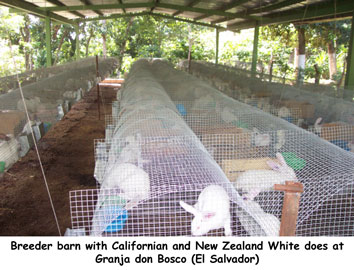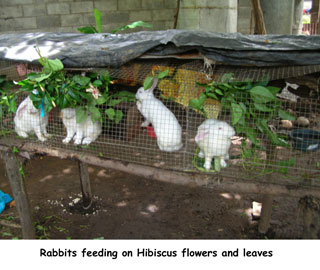|
This project was started by Partners
of the Americas to assist in development of a rabbit industry in El
Salvador by providing training and assistance to farmers large and small,
students and other technical persons. An important result was to train
the participants to build cages entirely of welded mesh wire. Because
of the shortage of lumber and its resulting high cost, these cages,
at about US$9 each, are more environmentally friendly and less expensive
than those constructed of 2"x 2" (5x5 cm) lumber, chicken
wire and hardware cloth.
|
Several formal training
sessions were presented in various locations and to diverse groups. Topics
included Introduction to Rabbit Production, Housing, Diseases, Genetics,
a hands-on cage building training session, practice in rabbit processing
and a round table discussion.
|
|
In the first year of the program,
Juan Carlos, who was the Secretary/Treasurer of the rabbit producer's
association but had no rabbits, listened avidly and took copious notes.
At one point during a field trip, he pointed out a location on a nearby
hillside that he said was his farm. A year later he had his commercial
farm near La Libertad, Granja don Bosco, in operation with 200 producing
does and was selling 100 -150 dressed fryers (2 lb - about 0.9 kg) each
week to four stores in one of the supermarket chains. He was paid US$1.90
per pound and the store sold the whole carcasses for US$2.45 per pound.
All of his rabbits are in all wire cages. He feeds the local feed (which
costs US$7.50 per 100 pounds) mixed half and half with Purina feed from
Guatemala (US$10.45 per 100 pounds). He says the quality of the local
feed is insufficient to maintain the level of production that he needs
but the cost of the feed from Guatemala is too high for him to make
a profit.
|
On the other
end of the scale, Don Concepcion in Tamasha has about six breeding does.
He participated in training sessions and learned about using local green
feeds for his rabbits. He and four other farmers in the area sell rabbits
to a restaurant at the entrance to El Impossible National Park. They sell
about 16 lb of 2-4 lb carcasses each month at US$2.30 per pound. If they
have rabbits they can't sell, they eat them. They like to use the commercial
feed, but when they feed it as a sole diet to all the rabbits, the sales
cover the cost of their feed but don't leave enough money to buy more
cages and expand their production. They felt the commercial feed was necessary
because it helped their litters to survive. To keep the feeding value
of the commercial feed while making the feeding regime affordable, they
now use the commercial concentrate for the does but finish the fryers
on green feeds and milo. This has allowed them to make a profit and consider
adding more cages and breeding does.
|
 |
 |
|
|
| |